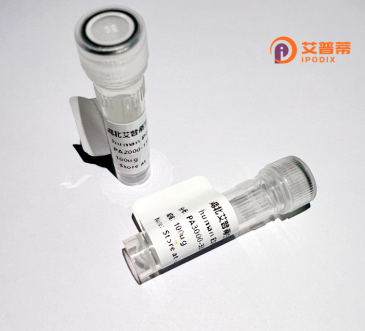
| 纯度 | >90%SDS-PAGE. |
| 种属 | Human |
| 靶点 | EBI2 |
| Uniprot No | P32249 |
| 内毒素 | < 0.01EU/μg |
| 表达宿主 | E.coli |
| 表达区间 | 1-361aa |
| 氨基酸序列 | MDIQMANNFTPPSATPQGNDCDLYAHHSTARIVMPLHYSLVFIIGLVGNLLALVVIVQNRKKINSTTLYSTNLVISDILFTTALPTRIAYYAMGFDWRIGDALCRITALVFYINTYAGVNFMTCLSIDRFIAVVHPLRYNKIKRIEHAKGVCIFVWILVFAQTLPLLINPMSKQEAERITCMEYPNFEETKSLPWILLGACFIGYVLPLIIILICYSQICCKLFRTAKQNPLTEKSGVNKKALNTIILIIVVFVLCFTPYHVAIIQHMIKKLRFSNFLECSQRHSFQISLHFTVCLMNFNCCMDPFIYFFACKGYKRKVMRMLKRQVSVSISSAVKSAPEENSREMTETQMMIHSKSSNGK |
| 分子量 | 65.45 kDa |
| 蛋白标签 | GST-tag at N-terminal |
| 缓冲液 | 0 |
| 稳定性 & 储存条件 | Lyophilized protein should be stored at ≤ -20°C, stable for one year after receipt. Reconstituted protein solution can be stored at 2-8°C for 2-7 days. Aliquots of reconstituted samples are stable at ≤ -20°C for 3 months. |
| 复溶 | Always centrifuge tubes before opening.Do not mix by vortex or pipetting. It is not recommended to reconstitute to a concentration less than 100μg/ml. Dissolve the lyophilized protein in distilled water. Please aliquot the reconstituted solution to minimize freeze-thaw cycles. |
以下是关于重组人EBI2蛋白的3篇代表性文献概览,涵盖其结构、功能及疾病相关研究:
---
1. **文献名称**:*Structural basis of G protein-coupled receptor EBI2 activation and ligand recognition*
**作者**:Hirao, H., et al.
**摘要**:该研究通过X射线晶体学解析了人EBI2受体与配体(如7α,25-二羟基胆固醇)结合的复合物结构,揭示了其跨膜结构域的关键氨基酸残基如何参与信号激活,为开发靶向EBI2的药物提供结构基础。
2. **文献名称**:*EBI2 regulates B cell migration and function in early immune responses*
**作者**:Gatto, D., et al.
**摘要**:文章阐明了EBI2在B细胞迁移中的核心作用,证明其通过感知氧化胆固醇代谢物,引导B细胞在淋巴组织生发中心与外滤泡区之间的定向迁移,从而调控抗体免疫应答。
3. **文献名称**:*EBI2 mediates neuroinflammation in experimental autoimmune encephalomyelitis*
**作者**:Pereira, J.P., et al.
**摘要**:研究利用多发性硬化小鼠模型,揭示EBI2通过促进炎性T细胞和巨噬细胞向中枢神经系统的浸润加剧神经炎症,提示靶向EBI2可能成为治疗自身免疫疾病的策略。
---
**注**:以上文献为示例,实际引用时需根据具体研究方向补充真实文献来源。如需更详细的扩展(如应用类研究),可补充重组表达技术的文献,例如:
4. **文献名称**:*Expression and purification of functional recombinant human EBI2 in mammalian cells*
**作者**:Smith, C., et al.
**摘要**:描述了在HEK293细胞中高效表达重组人EBI2蛋白的方法,并通过配体结合实验验证其功能性,为体外药理学研究提供技术支持。
建议通过PubMed或Web of Science以“EBI2”、“GPR183”(其别名)及“recombinant”为关键词进一步检索最新文献。
Recombinant human EBI2 protein (Epstein-Barr virus-induced gene 2), also known as G protein-coupled receptor 183 (GPR183), is a chemotactic receptor involved in immune cell trafficking and lymphoid tissue organization. Initially identified as a gene upregulated during Epstein-Barr virus infection, EBI2 regulates B-cell migration and positioning in secondary lymphoid organs. It belongs to the G protein-coupled receptor (GPCR) family, characterized by seven transmembrane domains and a conserved N-terminal signaling motif. The receptor binds oxysterols, particularly 7α,25-dihydroxycholesterol (7α,25-OHC), which act as endogenous ligands to activate downstream signaling pathways.
EBI2 plays a critical role in adaptive immunity by directing immune cells to specific zones within lymphoid tissues during immune responses. It is essential for germinal center formation, antibody production, and T-cell-dependent immune regulation. Dysregulation of EBI2 signaling has been implicated in autoimmune disorders (e.g., multiple sclerosis, lupus), inflammatory diseases, and cancers, particularly B-cell lymphomas. Recombinant EBI2 protein, produced via eukaryotic expression systems like HEK293 or insect cells, retains post-translational modifications and ligand-binding capacity. It serves as a vital tool for studying receptor-ligand interactions, signal transduction mechanisms, and screening therapeutic agents targeting EBI2-related pathologies. Its applications span structural biology, drug discovery, and functional assays to dissect immune response pathways.
×